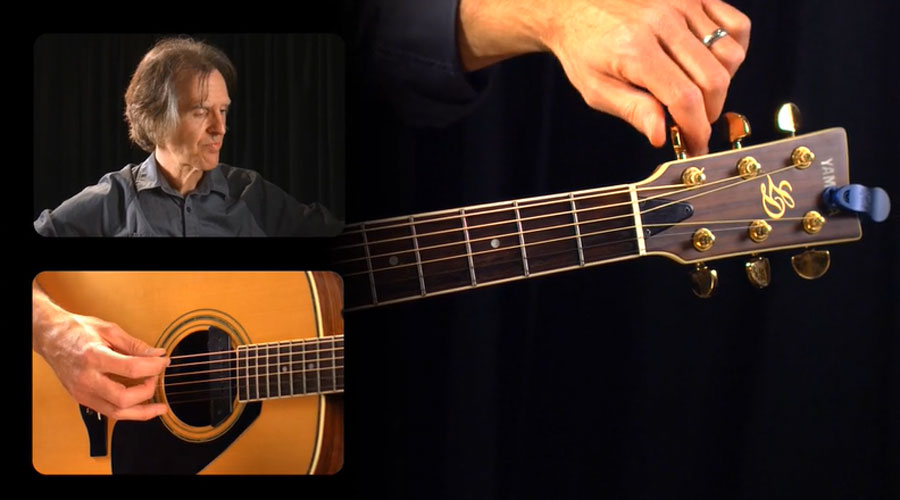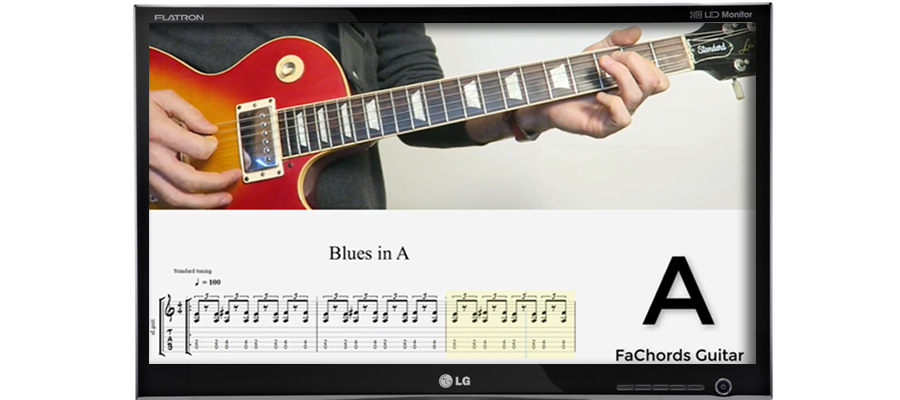How To Learn Guitar
Beginner's Guitar Learning Roadmap
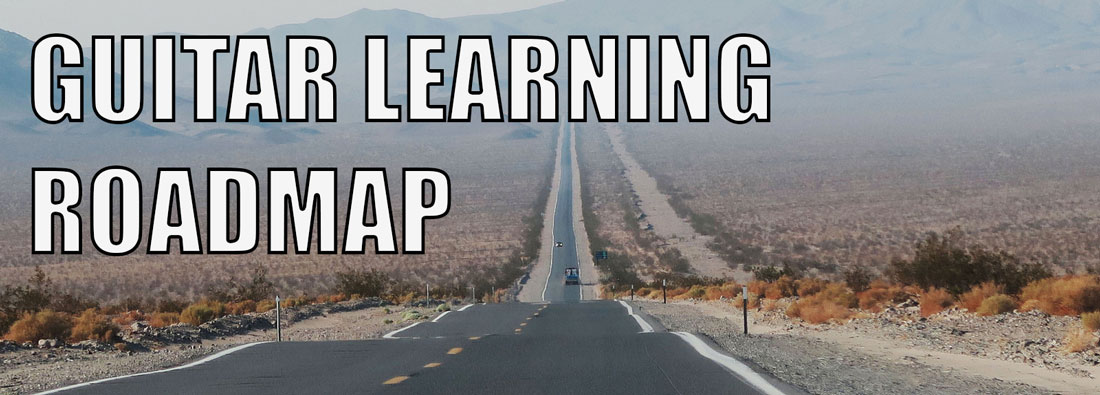
This guide is specifically for beginners who never picked up a guitar before and need to know how to start learning guitar.
If you already know some chords you can jump to the guitar lessons section, where you'll find plenty of tutorials, and have fun with the interactive learning software .
If you are at the beginning of your journey, please keep reading this guide to know the first steps to learning guitar.
And remember, you are never too old to learn guitar!
So you want to learn how to play the guitar?
Congratulations! With the right instructions and correct practice, in some months, you'll be able to play some of your favorite songs.
You'll entertain your friends and family with the easiest tunes by Eagles", The Beatles, Lynyrd Skynyrd, Aerosmith, Creedence, AC/DC , and many others. You can even begin composing your own little songs and melodies.
The Journey Analogy
The journey to being a great guitar player is much like a road trip across the country.
There is a variety of routes to take and some of the trip is exciting while other parts are just long stretches of endless highway.
We could start In New York City and travel to Los Angeles by taking a direct route or wondering all about the US.
In reality the best route would be one that includes some great scenery, some awesome tourist stops, yet still get us to our destination in a reasonable time.
That is the plan with our Guitar Roadmap , to show you the most interesting and important aspect of guitar training along with a reasonably timed “trip” to mastering the guitar.
Getting to Know Your Instrument
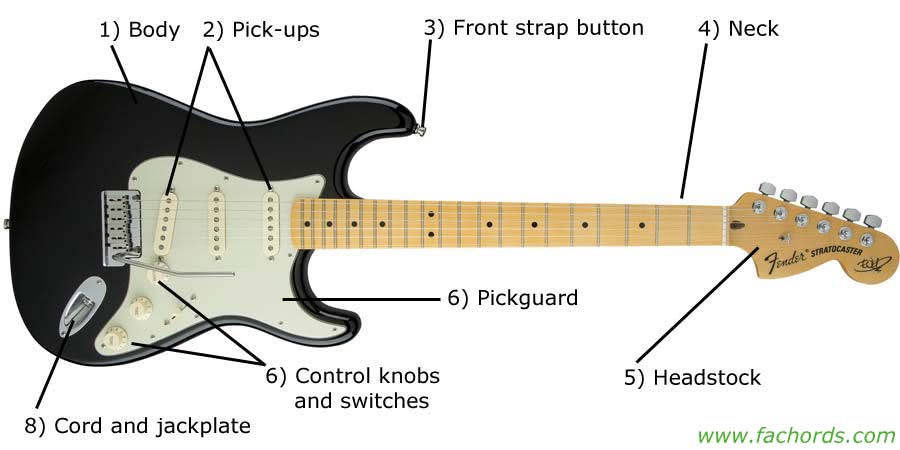
First off we need to start our journey by choosing the correct guitar.
Are you looking to shred some amazing metal solos?
Then you will need an electric guitar.
Are you you looking to sing original country-western or folk songs? Then I would suggest an acoustic.
And if you are looking to play some old style Hank Williams or Patsy Cline music, you might be looking for a slide guitar.
First advice: start with an acoustic guitar
An acoustic guitar is great because you don't have to deal with amps, cables, and other stuff that at the beginning could make things more complex.
Action and Intonation
It is also important to have great action and intonation.
What is Action
The action of a guitar is how hard it is to press down on the strings, it shouldn’t be so hard that it hurts your fingers, nor should it be so easy that the strings buzz the frets.
What is Intonation
The intonation is the tone of every fret on the guitar, each fret should play the corresponding note.
If they are slightly sharp or flat, the chords you play will sound off and terrible.
The Bottom Line
To start, find a good acoustic guitar ; you can borrow one from a friend, or go to the shops, the important thing is that the instrument must have proper action and intonation, your life will be easier.
Strings and Frets
You should know the name of the strings, and how frets are numbered.
Guitar Strings

Standard guitars have 6 strings, which are named in the following way:
- 1st string - E (the thinnest, highest pitch)
- 2nd string - B
- 3rd string - G
- 4th string - D
- 5th string - A
- 6th string - E (the thickest, lowest pitch)
So, when you have your guitar in your hands, the string nearest to the floor is called " 1st string " (the thinnest one)
To memorize the names of strings, you could use a mnemonic sentence like this: E ddie A te D ynamite G ood B ye E ddie (it would be better you invent your own sentence).
Guitar Frets
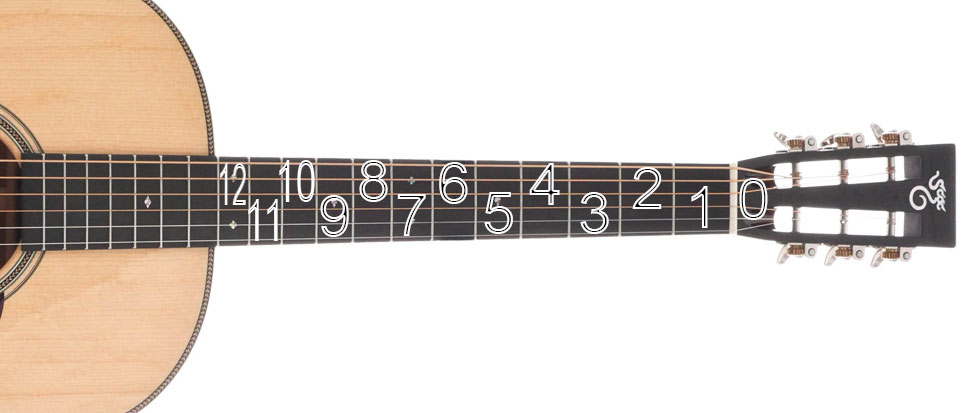
Each string has some frets, that are counted from 0 to 22 (or 23, or 24, depending on the guitar model).
For now, we can focus on frets from 0 to 12.
The higher the number, the higher the pitch.
When we say fret 0 , we mean the string without pressing any fret (open string).
How To Tune a Guitar
Every time you practice, you must be sure that your guitar is correctly tuned.
The video below shows you how to tune your guitar, be sure to watch it
There are a few important tools of the trade to help you with your playing.
One of the most important is the tuner.
These days they have a variety of tuners and in fact many smartphones have apps for tuning specific instruments.
I personally use a decent tuning app that way it is always on my smartphone or tablet ready when I need it
Correct Posture
It's wise to learn the correct posture right now .
Bad posture can turn out in back pain and other physical issues.
The video below it's a great introduction to this topic.
How To Hold The Guitar Pick
You can strum the strings with your fingers, but certain styles require to use a guitar pick. Check the how to hold a pick tutorial for details.
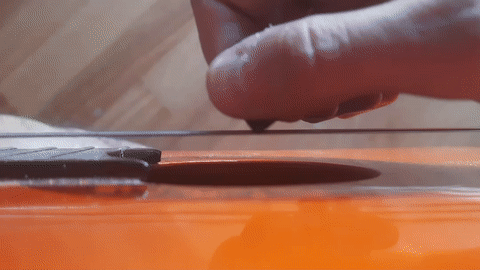
The Left Hand
The mission of the left hand is to press the strings to get the notes we want.
We need to have the fingers of the left hand in the right position before the right hand strums the strings.
In the beginning, the left hand will take care of the chords position, while scales, legato, glissato and other techniques will be learned in a more advanced stage.
Thumb position
The classic position of the thumb is at the center of the back of the neck .
The thumb provides the right force to the grip with the other fingers of the left hand.
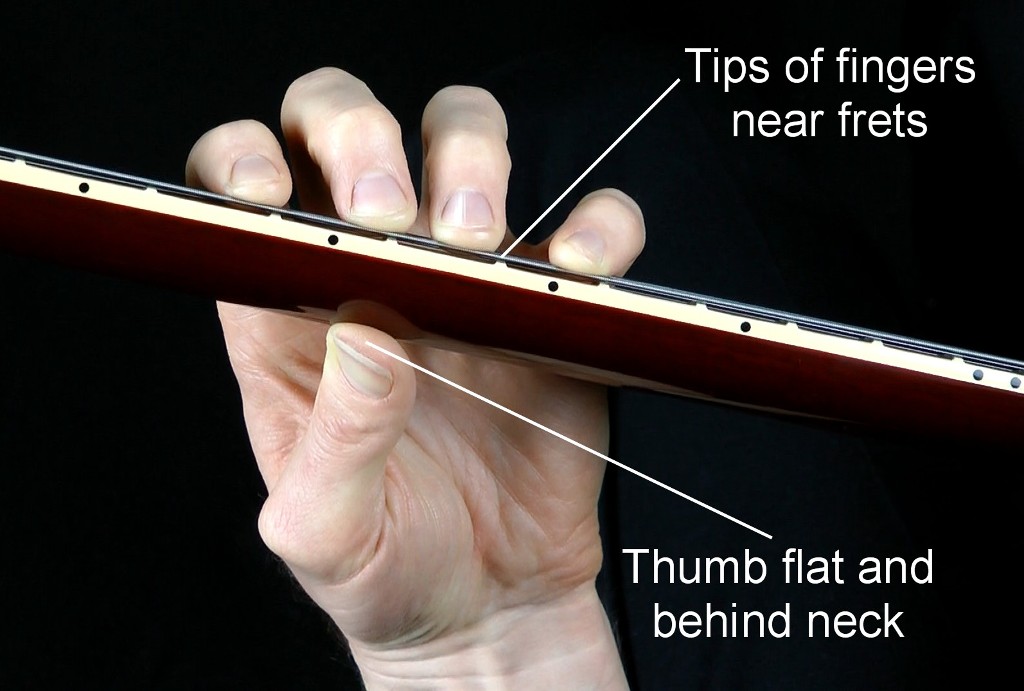
Image credit: http://www.jasonwerkema.com/resources/acoustic-guitar/
How to press the strings
When pressing a string, index, middle, ring and pinky fingers must be perpendicular to the fretboard, so they don't touch the other strings.
It's important to use the fingertips (the green area in the image below); you'll feel a bit of pain, because you have to build up callouses .
Be patient; it's amatter of a couple of weeks of daily practice (at least 10 minutes a day).
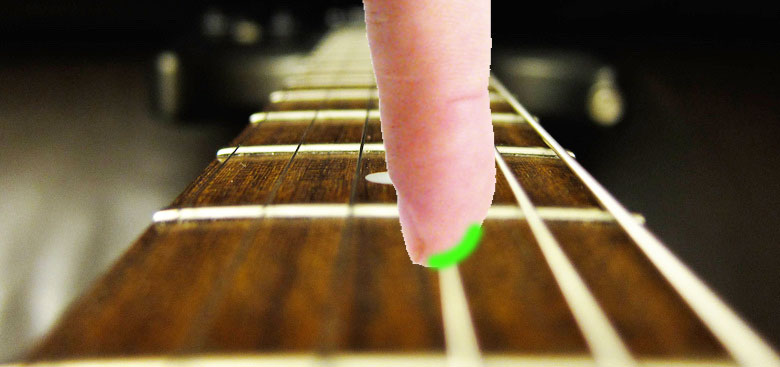
We press the string between two metallic frets, near the highest fret (the one at the right).
You should apply the right force : enough to make the string sound clear, but not too much, otherwise, you'll experiment fatigue and pain.
Learn How To Read Chords Box
The first thing you want to learn is how to read chords diagrams.
This is the easier way to show where to place your fingers and which string to strum.
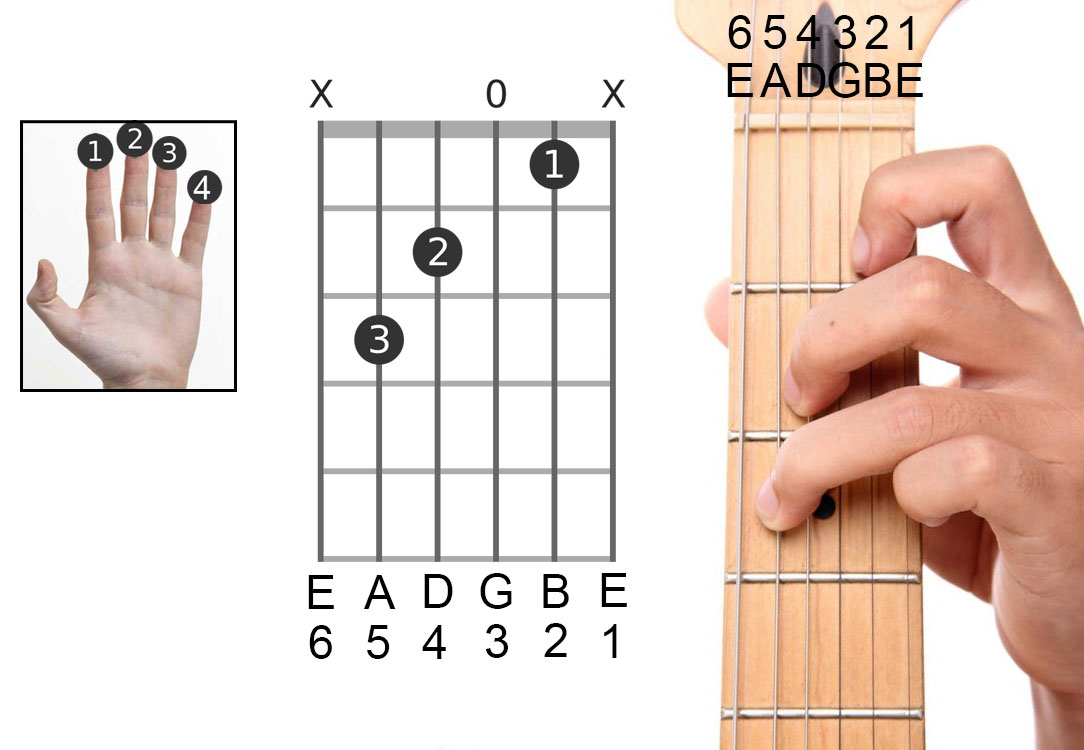
In the upper area of the diagrams, we could find a X or a 0, in correspondence of each string.
The X means that we don't play the string, while the 0 means that we play the string without pressing any fret (open string).
If there are no X or 0, we play the fret marked with the black dots.
The number in the black dots tell which finger to use: 1: index, 2: middle, 3: ring, 4: pinky
Your First Chords
There are so many chords out there , some in open position and easy to play, others real finger stretchers that will push your pinky to the breaking point.
As a beginner you want to stick to the basic chords.
The key is to understand that it takes time to form these chords and you need to train your muscle memory. Muscle memory is just like regular memory in that it needs practice, rest, and time.
Practice is very important and needs to be done regularly but you also need to learn to give yourself a day’s rest a couple times a week so your fingers can heal.
Sometimes chords can seem nearly impossible to play, but if you stick with them you will get it.
I have given lessons to those with fat fingers, stubby fingers, long fingers, and even very short fingers, over time those who stick with it always learn their chords.
Here are your first chords to learn:
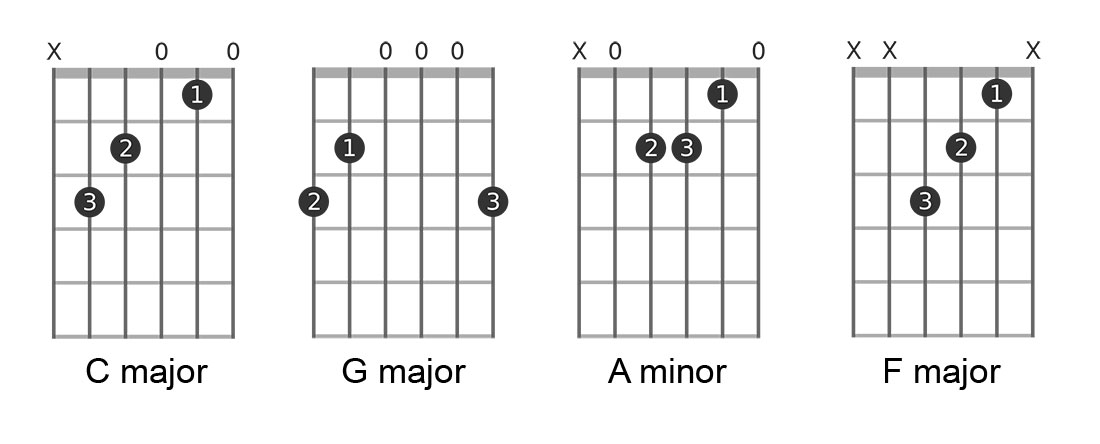
Almost every chord has a variation so there are a number of ways to " cheat " if you are having trouble learning.
That is why it is so important to always study your chord dictionary.
Here's a simplified version of the same chords:
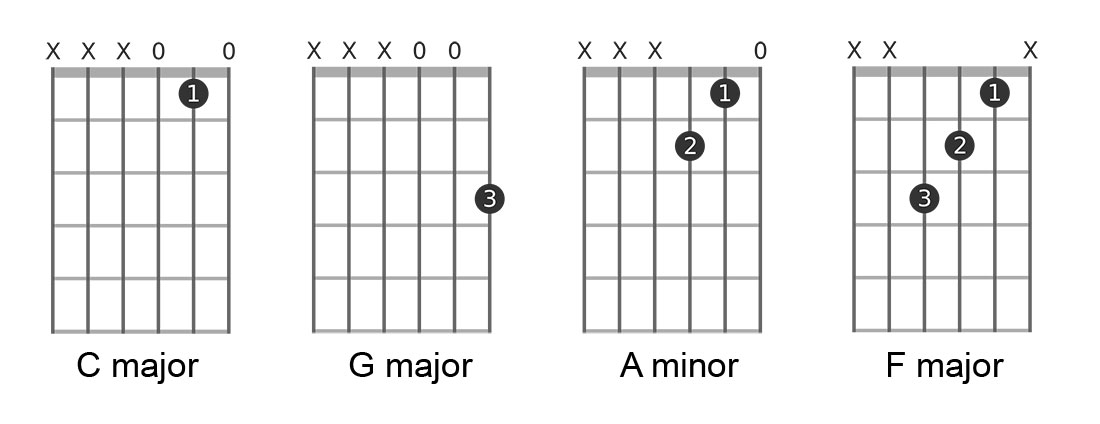
Use These Chords to Play Songs
One of the greatest ways to master the guitar is by learning as many songs as you can .
When the internet first started booming I remember spending hours just searching for the chord progression of every song I liked.
Often the chords of the song only give you the simple skeleton of the piece but that is often enough to flesh the song out.
It may seem like a haphazard way to learn but sitting with your guitar and your computer or tablet for hours on end just looking up songs you know is an amazing way to learn new chords and discover new strums.
The good news is that the 4 chords you have just learned, will allows you to play a great number of pop and rock songs.
Not convinced? Have a look at this video. All the songs are played with the same C, G, Am and F chords!
All the songs in this video use the same C, G, Am and F chords
Awesome isn't it? Now go on Youtube and play along one of the songs listed below, trying to follow the rhythm, you'll be surprised!
- Journey – "Don't Stop Believin'"
- The Black Eyed Peas – "Where Is the Love"
- Alphaville – "Forever Young"
- The Beatles – "Let It Be"
- Bob Marley – "No Woman, No Cry"
- Joan Osborne – "One of Us"
- Avril Lavigne – "Complicated"
- The Offspring – "Self Esteem"
- Men At Work – "Down Under"
- Jack Johnson – "Taylor"
- Spice Girls – "2 Become 1"
- A-ha – "Take On Me"
- Green Day – "When I Come Around"
- Eagle Eye Cherry – "Save Tonight"
- Toto – "Africa"
- Beyoncé – "If I Were A Boy"
- Kelly Clarkson – "Behind These Hazel Eyes"
- Train – "Hey, Soul Sister"
- Elton John – "Can You Feel the Love Tonight" (from The Lion King)
- Akon – "Don't Matter"
- John Denver – "Take Me Home, Country Roads"
- Lady Gaga – "Paparazzi"
- U2 – "With Or Without You"
- The Last Goodnight – "Pictures of You"
- Maroon 5 – "She Will Be Loved"
- Bon Jovi – "It's My Life"
- Lady Gaga – "Poker Face"
- Aqua – "Barbie Girl"
- Red Hot Chili Peppers – "Otherside"
- The Gregory Brothers – "Double Rainbow Song"
- Andrea Bocelli – "Time to Say Goodbye"
- Robert Burns – "Auld Lang Syne"
- Five for Fighting – "Superman"
Next Roadmap Step: Jump To The Free Guitar Lessons
Well, I hope this short introduction has stimulated your curiosity and enthusiasm.
The next step is to ask yourself what kind of guitar player you want to become , and find the right learning resource that will help get there.
- As a beginner guitarist, you need structure and consistency.
- You need lessons that build on one another in a logical and step-by-step way.
FaChords Guitar provides you with plenty of free guitar lessons about all the aspects of the instrument.
They are grouped in beginner, intermediate and advanced level.
Click the button below to get started!
To your success on guitar!
FAQ
As a complete beginner, what type of guitar is recommended to start learning on?
For absolute beginners, an acoustic guitar is highly recommended. It simplifies the learning process because you don't need to manage amplifiers, cables, and other electronic equipment right from the start, allowing you to focus purely on playing technique.
Why are 'action' and 'intonation' important considerations for a beginner's guitar?
'Action' refers to how difficult it is to press the strings; it should be comfortable, not too hard to hurt your fingers, nor too easy to cause buzzing. 'Intonation' ensures that each fret plays the correct note. Both are crucial because good action and intonation make the guitar easier and more enjoyable to play, preventing frustration caused by uncomfortable strings or out-of-tune notes.
How can I remember the names of the six guitar strings?
Standard guitars have six strings named E, B, G, D, A, E. The 1st string (thinnest, highest pitch) is E, and the 6th string (thickest, lowest pitch) is also E. A common mnemonic to remember them from thickest to thinnest is 'Eddie Ate Dynamite, Good Bye Eddie'.
What is the correct way to position my left hand and fingers when pressing guitar strings?
For correct left-hand posture, your thumb should rest at the center of the back of the guitar neck, providing support. Your index, middle, ring, and pinky fingers should be positioned perpendicular to the fretboard, pressing down on the strings using only your fingertips. Aim to press the string between two metallic frets, closer to the higher fret, applying just enough force for a clear, ringing sound.
How do I interpret the symbols on a guitar chord diagram?
On a chord diagram, an 'X' above a string means that string should not be played or strummed. A '0' indicates an open string, which means you play that string without pressing any fret. The black dots show where to place your fingers, and the numbers inside these dots indicate which finger to use: 1 for index, 2 for middle, 3 for ring, and 4 for pinky.
Why is it important to take rest days when practicing new chords and building callouses?
Learning new chords involves building 'muscle memory' in your fingers and developing callouses on your fingertips. Like regular memory, muscle memory requires practice, rest, and time to consolidate. Taking a couple of rest days per week allows your fingers to heal, preventing pain, fatigue, and potential injury, which is essential for consistent and effective progress.
Can I really play a lot of songs even if I only know a few basic chords?
Yes, absolutely! The tutorial demonstrates that with just a few fundamental chords, like C, G, Am, and F, you can play a surprisingly large number of popular rock and pop songs. These basic chord progressions form the 'skeleton' of many well-known tunes, allowing you to start playing along and enjoying music very quickly.
